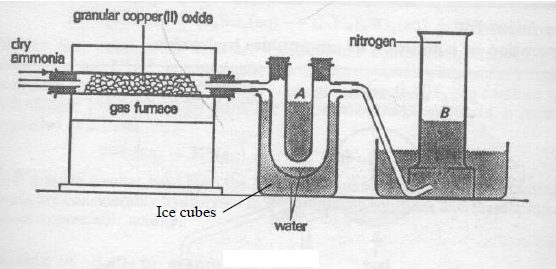- It reduces oxides of metals below iron in the reactivity series.
Experiment: reaction between ammonia and copper (II) oxide.
(i). Apparatus.

(ii). Procedure:
- Copper (II) oxide is heated strongly and dry ammonia is passed over it.
- The products are then passed through a U-tube immersed in cold water (ice cubes).
(iii). Observations.
- The copper (II) oxide glows as the reaction is exothermic.
- A colourless liquid collects in the U-tube.
- A colourless gas is collected over water.
- The black copper (II) oxide changes to brown copper metal.
(iv). Explanations.
- Ammonia gas reduces copper (II) oxide to copper and is itself oxidized to nitrogen and water.
- The water produced condenses in the U-tube immersed in cold (ice) water.
- The resultant nitrogen is collected by downward displacement of water.
- The nitrogen gas collected is ascertained indirectly as follows:
A lighted splint is extinguished and the gas does not burn; thus it is not oxygen, hydrogen, or carbon (II) oxide.
It has neither smell nor colour; it is not ammonia, chlorine, sulphur (IV) oxide or nitrogen (IV) oxide.
It is not carbon (II) oxide because it does not turn lime water into a white precipitate.
Ice cubes
Note:
- This experiment proves that ammonia contains nitrogen.
Kavungya answered the question on
April 30, 2019 at 10:24